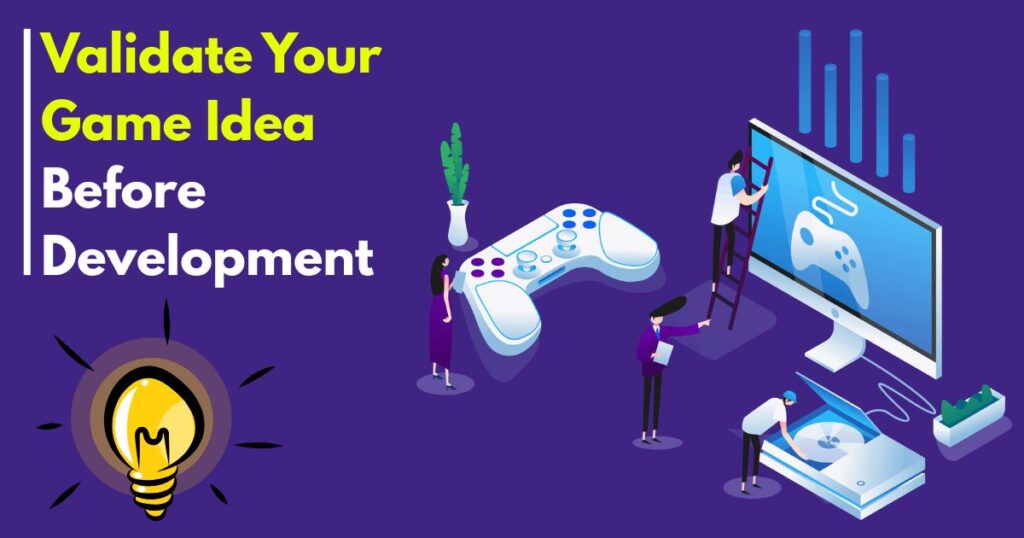Before investing heavily in game development, validating your game idea is essential. In 2024, the global gaming market reached a valuation of $282 billion, with over 3.3 billion active gamers worldwide. Despite these figures, nearly 80% of indie games fail to recover their development costs due to poor planning and untested ideas.
Hiring a development team too early, without real validation, can result in wasted time, money, and effort. Whether you’re aiming to build a mobile game, a console title, or a VR experience, it’s critical to ensure your concept has real market potential. For those planning to hire Unity game developers, it’s wise to first test and refine your idea using proven strategies.
This guide walks you through effective ways to validate your game idea—technically, practically, and economically—before you bring developers on board.
Why Validation Matters Before Development
Creating a game is an expensive process. Validation helps you:
- Avoid building games no one wants to play
- Understand your target audience early
- Identify flaws in mechanics or concept
- Gauge market competition and differentiation
- Prioritize development features based on actual demand
Developing games without validation often leads to feature creep, missed deadlines, and poor market fit. These issues become especially costly when working with hired developers.
Step 1: Define Your Game Idea Clearly
Before seeking validation, document your idea with clarity.
Key elements to define:
- Core gameplay mechanics
- Target platform(s): mobile, console, desktop, VR, etc.
- Game genre: puzzle, FPS, RPG, strategy
- Monetization strategy: in-app purchases, ads, premium sales
- Target audience: age group, geography, player preferences
Example:
“A 2D puzzle-platformer where players manipulate light and shadows to solve increasingly difficult levels. Target platform: Android and iOS.”
This level of clarity helps when presenting the concept to testers, designers, or investors.
Step 2: Conduct Market Research
Game validation starts with knowing your competition and market demand.
Tools to use:
- SteamDB and App Annie for genre trends
- Sensor Tower for mobile game statistics
- Google Trends for keyword interest
- Reddit/GameDev and Discord for community insights
Questions to answer:
- Are similar games popular?
- What features do players praise or criticize?
- How saturated is the genre?
Example:
If you’re building a match-3 game, you’ll face competition from major studios. You’ll need to prove your concept offers a fresh angle or added value.
Step 3: Build a Low-Fidelity Prototype
Before you hire Unity game developers, create a paper prototype or basic digital mockup. This allows you to test the core mechanics without code-heavy investments.
Tools for prototyping:
- Unity (free tier) for basic scenes
- Figma or Adobe XD for UI/UX mockups
- Trello to manage early feedback
Benefits of early prototyping:
- Visualizes gameplay
- Validates mechanics with early users
- Helps you pitch the idea more clearly
Step 4: Run Playtesting Sessions
Let real users interact with your prototype.
How to conduct effective playtests:
- Use platforms like PlaytestCloud or UserTesting
- Record sessions to analyze user behavior
- Ask specific questions: What confused you? What did you enjoy most?
Metrics to track:
|
Metric |
Why It Matters |
|
First-Time User Retention |
Measures initial engagement |
|
Session Length |
Indicates user interest and immersion |
|
Exit Points |
Identifies where users quit or lose interest |
Short tests with five to ten users can reveal major flaws or confirm appeal.
Step 5: Create a Landing Page or Teaser
Set up a simple web page describing your game idea. Include:
- Game concept
- Artwork or screenshots
- Email sign-up for beta access
- Survey for interest
Tools to use: Carrd, Webflow, Wix, or WordPress.
You can validate demand based on:
- Click-through rates on social ads
- Email subscriptions
- Survey completion rates
Case Example:
An indie studio gained over 2,000 email subscribers in 3 weeks after launching a simple teaser page for their zombie shooter game. This helped them secure funding before hiring a Unity team.
Step 6: Use Social Media for Soft Validation
Leverage platforms like Twitter, TikTok, LinkedIn, and Reddit to test market interest.
What to post:
- Concept art or GIFs
- Quick dev logs
- Polls and feedback questions
Best platforms for indie games:
|
Platform |
Strengths |
|
|
Quick engagement from devs and players |
|
|
Honest feedback in niche communities |
|
TikTok |
High viral potential with visuals |
|
|
Good for attracting professional attention |
Step 7: Launch a Minimal Viable Game (MVG)
An MVG is a basic, playable version of your game that includes only the core features.
Why MVG works:
- Saves costs before full development
- Shows whether users engage with gameplay
- Provides real analytics for improvement
Example:
Before developing “Among Us,” the creators launched a simple prototype to test multiplayer interest. They iterated based on feedback and eventually found viral success.
For MVGs, this is a good stage to hire Unity game developers on a short-term contract. They can assist with performance optimization, game loop polishing, and bug fixing.
Step 8: Validate Monetization Strategy
A game with engagement but no revenue potential is risky. Test your monetization early.
Strategies to test:
- In-app purchases (IAPs)
- Ads (rewarded, interstitial)
- Subscription models
- Premium one-time purchase
How to test:
- Create dummy buttons or pop-ups in prototype
- Measure click-throughs or mock purchases
- Survey testers about pricing expectations
Stat: According to GameAnalytics, only 2.2% of users make in-app purchases, so design monetization accordingly
Step 9: Get Feedback from Developers and Designers
Once you’ve validated user interest, consult experienced developers before hiring.
They can:
- Identify technical risks
- Suggest optimization strategies
- Estimate development time and costs
Bring this data to your Unity developer or studio discussions. It helps you scope accurately and avoid mid-project surprises.
Step 10: Document and Plan Before Hiring
Prepare these documents before you hire Unity game developers:
- Game Design Document (GDD): Details game logic, mechanics, flow, assets
- User Personas: Describes your target audience
- Market Research Summary: Showcases competitors, trends, and potential
- MVP Roadmap: Defines must-have features for launch
Well-documented planning helps developers work faster and with fewer revisions.
Conclusion
Validating your game idea is a critical step that determines your project’s success or failure. It ensures you don’t build in the dark or spend resources without traction. Whether you’re a solo entrepreneur, a studio, or a business leader, idea validation should always precede development.
By testing the concept, engaging users, and measuring interest, you ensure that the game you build has both technical viability and market appeal. Once confident, you can then hire Unity game developers with a clear scope, budget, and roadmap—setting your game on a strong foundation for success.
FAQs
1. How much should I spend on game validation?
You can validate a concept with as little as $100–$500 using online tools, basic prototypes, and ads.
2. Should I build an MVP before hiring developers?
Yes, especially if you’re testing the market. Once validated, hire Unity developers for technical builds.
3. Can I validate a game idea without programming skills?
Yes. Use paper prototypes, mockups, and no-code platforms to simulate gameplay and collect feedback.
- How to Validate Your Game Idea Before Hiring Unity Game Developers – Complete Guide 2025
- Validate your game idea with confidence before you hire Unity game developers. Learn proven methods, real examples, and key metrics to ensure your concept is market-ready and worth developing.
- game idea validation, validate game concept, hire Unity game developers, game development planning, Unity game validation, game prototype testing, market research for games, MVP for games, indie game development, Unity game testing
Related posts:
 High-Quality Biomedical Waste Incinerators & Laboratory Glassware Made in India
High-Quality Biomedical Waste Incinerators & Laboratory Glassware Made in India
 Understanding the Role of IoT in Modern Manufacturing: A Comprehensive Guide to Smart Factories and Industrial Transformation
Understanding the Role of IoT in Modern Manufacturing: A Comprehensive Guide to Smart Factories and Industrial Transformation
 Smarter Business Networks Start with a Cisco Solution Provider Partner
Smarter Business Networks Start with a Cisco Solution Provider Partner
 Best Account Management Software for All Businesses – EmizenTech
Best Account Management Software for All Businesses – EmizenTech
 Top 15 Global Website Design Companies You Can Hire in the 2025
Top 15 Global Website Design Companies You Can Hire in the 2025
 Empowering Qatari Retail Businesses with Microsoft Dynamics 365 Commerce
Empowering Qatari Retail Businesses with Microsoft Dynamics 365 Commerce
 Safety Procedures in Heavy Equipment Moving: Best Practices for Workplace Security
Safety Procedures in Heavy Equipment Moving: Best Practices for Workplace Security
 How Microinteractions Are Revolutionizing Mobile UI/UX Design in 2025
How Microinteractions Are Revolutionizing Mobile UI/UX Design in 2025







